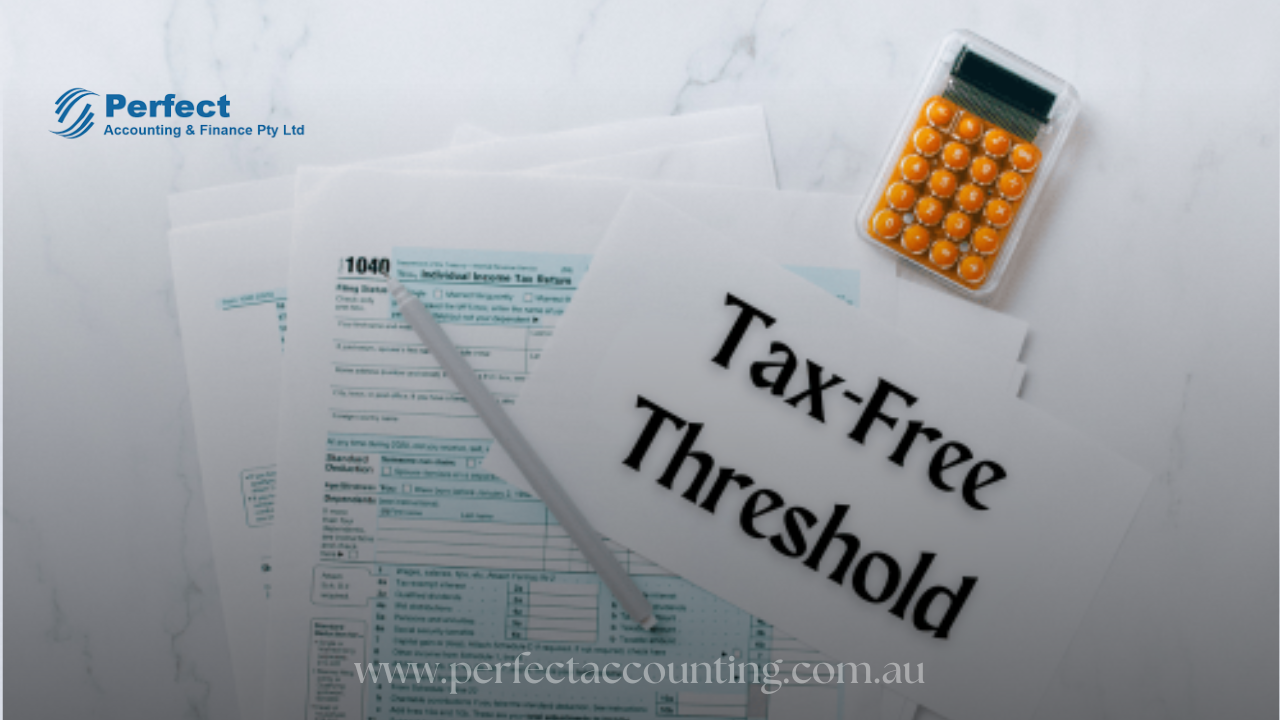When it comes to doing your taxes, there’s one phrase you’ve probably heard more than once — the tax-free threshold. But what does it actually mean? And more importantly, what happens if you don’t claim the tax-free threshold?
If you’re scratching your head wondering whether claiming this threshold really matters, you’re in the right place. In this article, we break everything down in plain English, share real-life stories, and offer a step-by-step guide to help you make the best choice — without the stress.
Pro tip: For any questions about your tax situation, it’s best to work with a trusted accountant like Perfect Accounting PTY Ltd — they’ve got your back!
What Is the Tax-Free Threshold?
Before diving into what happens if you don’t claim the tax-free threshold, let’s first understand what it is.
The tax-free threshold is the amount of money you can earn without paying any income tax. In Australia, this amount is currently $18,200 per financial year. If you earn less than this, you don’t pay any tax. Simple, right?
When you start a new job, you’ll fill out a Tax File Number Declaration form, where you can tick a box to claim the tax-free threshold from that employer.
So, What Happens If I Don’t Claim It?
Let’s cut to the chase. If you don’t claim the tax-free threshold, here’s what will happen:
1. More Tax Withheld from Your Pay
Your employer will assume you aren’t claiming any tax-free income, so they’ll withhold more tax from each paycheck. It’s like giving the ATO an interest-free loan.
Let’s say you work part-time and earn $400 a week. If you don’t claim the tax-free threshold, more tax is taken out each week — even though your total income is below $18,200!
♀️Real-life example: Emma’s First Job
Emma, a university student, landed her first job at a local cafe. She wasn’t sure what the tax-free threshold meant, so she left the box unchecked. A few months later, she realised her pay seemed lower than expected. Turns out, she was getting taxed unnecessarily. By not claiming the threshold, Emma was losing around $30 a week — that’s over $1,500 a year!
2. You Might Get a Refund Later (But It Takes Time)
Sure, if you don’t claim the tax-free threshold and end up paying too much tax, you may get it back when you lodge your tax return. But why wait months to get money that’s already yours?
That’s like buying something for $100 and getting told, “You’ll get $30 back — in July next year.” Wouldn’t you rather keep that money in your pocket now?
3. Risk of Overpaying or Underpaying
Here’s where things get tricky. If you have more than one job, you can only claim the tax-free threshold from one employer. If you mistakenly claim it from more than one, you may end up underpaying tax and owe the ATO at tax time.
Confused? Don’t worry — Perfect Accounting PTY Ltd can help you figure out which job should claim the threshold and sort everything out for you!
✅ Step-by-Step: How to Claim the Tax-Free Threshold
If you’re starting a new job or want to make sure you’re not overpaying, here’s what to do:
Step 1: Complete the Tax File Number Declaration Form
You’ll receive this from your employer when you start a new job. You can also find it online here.
Step 2: Tick “Yes” to Claim the Tax-Free Threshold
If it’s your main source of income, say “yes.” If it’s your second job, say “no” — unless your total income will still be under $18,200 for the year.
Step 3: Submit the Form to Your Employer
They’ll use this info to calculate how much tax to withhold from your pay.
When Should You Not Claim It?
There are situations where it’s better not to claim the tax-free threshold, such as:
-
You have two or more jobs and already claimed the threshold from one.
-
You expect to earn more than $18,200 combined across all jobs.
-
You’re working temporarily or expect to earn only a small amount from this employer.
♂️Example: John’s Side Gig
John works full-time as a teacher and also tutors part-time. Since he’s already claimed the threshold with his teaching job, he ticks “No” on his tutoring job. This prevents him from underpaying tax — and avoids a surprise bill later.
Common Questions People Ask
❓What if I Accidentally Don’t Claim It?
No need to panic. You won’t lose the money forever. The ATO adjusts it when you lodge your tax return. But if you’d rather keep more of your pay during the year, it’s worth getting it sorted sooner.
❓Can I Change My Choice Later?
Yes! You can submit a new Tax File Number Declaration to your employer anytime if your situation changes.
❓Will I Get in Trouble with the ATO?
Only if you try to claim the tax-free threshold from more than one employer, which could result in underpayment of tax. Honesty and clarity are key.
Why You Should Speak to an Expert
Understanding taxes shouldn’t be a guessing game. That’s why so many Australians rely on the experienced team at Perfect Accounting PTY Ltd. They offer expert tax advice, bookkeeping services, and business accounting solutions that make life easier — and can help you avoid common pitfalls like not claiming the tax-free threshold correctly.
Whether you’re:
-
A student working part-time,
-
A freelancer juggling gigs,
-
Or running your own business,
Perfect Accounting PTY Ltd is your go-to partner for staying tax-smart all year long.
Final Thoughts
Let’s wrap it up:
-
The tax-free threshold lets you earn the first $18,200 tax-free.
-
If you don’t claim it, more tax gets taken from your pay upfront.
-
You might get a refund later, but it’s better to avoid the hassle altogether.
-
Claiming it properly means more take-home pay and fewer surprises at tax time.
So, next time you fill out that tax form — pause, breathe, and remember what you’ve learned here.
And when in doubt?
Talk to Perfect Accounting PTY Ltd — they’re here to make your tax journey smoother, smarter, and stress-free.







